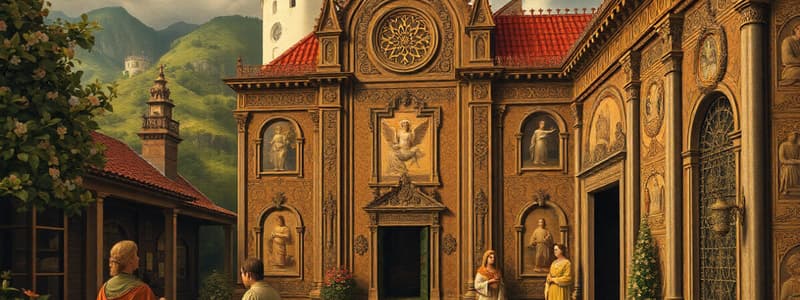Podcast
Questions and Answers
What technique did Duccio employ to create a sense of importance in figures within his works?
What technique did Duccio employ to create a sense of importance in figures within his works?
What art material did Duccio primarily use in his works?
What art material did Duccio primarily use in his works?
What style characteristic differentiates Duccio's work from earlier Byzantine art?
What style characteristic differentiates Duccio's work from earlier Byzantine art?
Which of the following features is notable in Duccio's 'Maestà' piece?
Which of the following features is notable in Duccio's 'Maestà' piece?
Signup and view all the answers
In the early works of Duccio, what aspect is often criticized regarding the depiction of angels?
In the early works of Duccio, what aspect is often criticized regarding the depiction of angels?
Signup and view all the answers
What does the lack of emotion shown by figures in Duccio's early works typically reflect?
What does the lack of emotion shown by figures in Duccio's early works typically reflect?
Signup and view all the answers
What quality of Duccio's style can be seen in the way he transitioned colors in his paintings?
What quality of Duccio's style can be seen in the way he transitioned colors in his paintings?
Signup and view all the answers
How did Duccio's depiction of figures differ from traditional representations in Byzantine art?
How did Duccio's depiction of figures differ from traditional representations in Byzantine art?
Signup and view all the answers
Study Notes
Duccio di Buoninsegna
- Italian painter from the Sienese School, active in the late 13th and early 14th centuries.
- Known for his elegant and refined style, using vibrant colors, intricate details, and a sense of spirituality.
- Influenced by Byzantine art but developed his own style, softening lines and creating images that appear more lifelike.
- The Madonna and Child (c. 1285) is one of Duccio's earliest works and demonstrates a lack of perspective.
- Utilizes gold leaf background, typical of Byzantine art.
- This piece shows a clear lack of perspective, with figures appearing stacked on top of each other.
- The Madonna displays sadness, a hint of emotion, while the figures in the Byzantine tradition are generally stoic.
Maestà
- Large altarpiece commissioned for the Siena Cathedral.
- Painted on multiple wood panels with tempera paints.
- Completed and installed in the cathedral on June 9, 1311.
- Displays a combination of Byzantine influences like gold leaf and delicate color transitions, along with new techniques like elaborate drapery and hierarchical perspective.
- Hierarchical perspective is visible in the relative size of the Virgin Mary and Christ child compared to the donors and surrounding saints, signifying their importance.
- Early example of perspective, with saints standing behind each other, signaling a shift away from the flat representations of medieval art.
- Focuses not only on biblical stories but aims to elicit emotional responses from viewers.
- Duccio's Maestà is recognized as a bridge between the Middle Ages and the Early Renaissance.
- His work paved the way for a more realistic style of painting.
Studying That Suits You
Use AI to generate personalized quizzes and flashcards to suit your learning preferences.
Description
Test your knowledge on the life and works of Duccio di Buoninsegna, a master of Italian painting in the late medieval period. Explore his renowned altarpiece, the Maestà, and its significance in art history. Delve into the influences and techniques that define Duccio's unique style.
